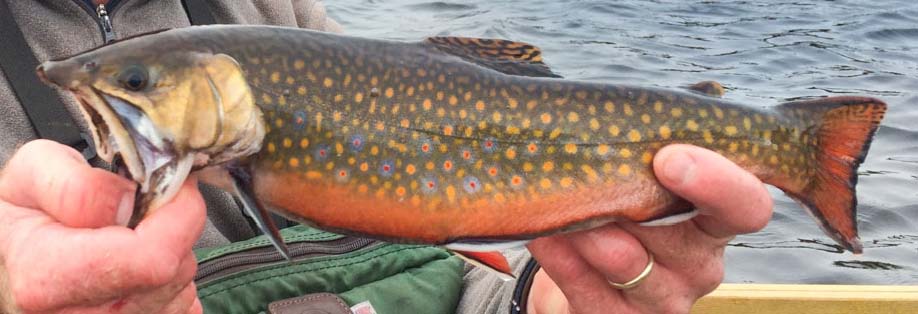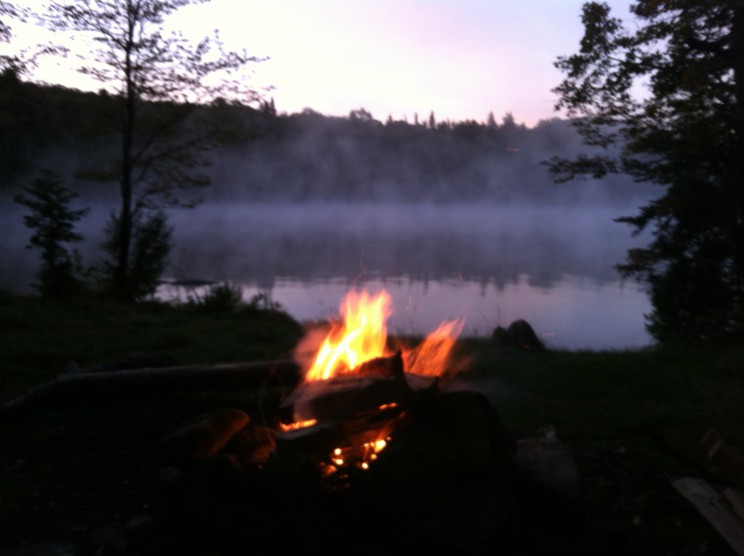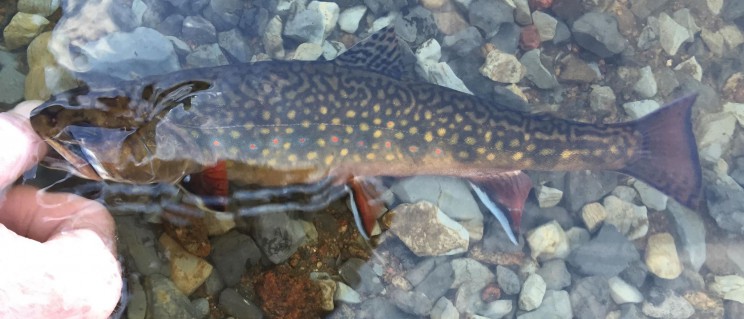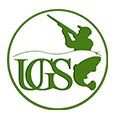

The first brook trout I caught was over thirty years ago. My Dad left me on the bank of a swollen Spring trout river on the Tug Hill with a can of worms, some hooks and split-shot, and instructions to not fall in or wander off. Perched high above a turbulent eddy hole on the precarious sod bank I drowned a worm and set the hook into a beautiful hook-jawed male brookie’ of about 16 inches in length and shaped like a nerf football.
Knowing this trout was a rare find, and big for its kind, it was not going back into the creek. It flopped around in the grass behind me as I continued to fish, awaiting the return of my Dad, glowing to show him the trout. He soon returned from downstream and smiled in delight when he saw the big trout!
We gutted the trout (as was usual back then) to add to our catch of browns in the back pocket of the fishing vest. In its’ stomach was the half-digested remains of a small bird! Was it a bat? A bank swallow? We could not tell much more than it was indeed a bird. The mental image of the bright colored hook-jawed brook trout leaping clear of the river’s surface and attacking a swooping bat or gliding swallow stayed with me for weeks afterwards. It was then and there I became fascinated with Fontinalis.
Since then I have pursued and caught wild brook trout all over New York State and the provinces of Manitoba, Ontario and Quebec. As a general rule, in each of these places, wild native brook trout fishing gets better the farther from civilization you retreat. Another reason I find it addicting.
Brook Trout are an easy fish to catch most of the time. The challenge with “squaretails” as down-easter fishermen call them, is they can be difficult to find. And by difficult I don’t mean tricky. I mean the “Carry your canoe through a few miles of woods, over blowdowns, through spruce swamps and over small mountains while black flies swarm you and turn your earlobes red with blood” kind of difficult.
If an angler sets out to fish for backcountry trout, they should first research their destination to be reasonably certain the pond or small lake they will hike into has a healthy population of trout. To discern this, state and provincial stocking lists are invaluable. Also, picking up the phone and calling hatchery managers and state or provincial fishery biologists is a good idea as they are a valuable source of information.
Once a good backcountry pond or group of ponds is decided upon, its time to organize an outfit. The wilderness is a safe place. And backcountry travel is not complicated. While hiring a guide will make your trip easier, it is really not necessary. It is best to not go alone into remote backcountry. And going light is essential. Most important is to be honest with yourself in regard to your physical condition and the distance you can safely and comfortably travel. Knowing how to read a map, use a compass AND a GPS are essential skills.
As for equipment, well, brook trout are not picky. I have never met one that turned his nose to a gold bead-headed black and rust wooly bugger. Light fly tackle is my preferred way of fishing for the trout. A five weight fast action rod with a floating weight forward line is adequate. The longer length rods, like 9’6″ or even 10′ in length are ideal for fly casting from the seat of a canoe.
Ultra-light spinning gear is effective and fun for brook trout. Gold and copper spinners and spoons tied to 4# or 6# monofilament is a simple recipe that is tough to beat! Small countdown Rapalas in gold and black or perch pattern are deadly. Deadly, however, in more than one way. Plugs such as the Rapala have two sets of treble hooks that are sticky sharp. Angling for trout with these plugs is high-impact on the trout… Something to consider. Creeling, or killing, wild brook trout is ok, but damaging or harming every one you catch is a bit much in my opinion.
Brook trout can grow big in North Country lakes and ponds that are forage-based feeding on a diet of smelt. The average wild backcountry brook trout is not a fish of giant proportion and a dose of perspective is required to admire a 12′ fish as if it was twice that size. What they lack in size, however, the book trout makes up with pure wildness. The country in which they live is as magnificent as any I have ever travelled and is the real reward of a day or two spent chasing squaretails.
While the rumor is that the best backcountry brook trout fishing takes place as soon as the ice goes out on the ponds in the early Spring, I have consistently caught more brook trout from mid May through the month of June. When insect activity climbs with the water temperature the ponds come alive and the fly caster can have a heyday.
If you are reading this and would like to pick my brain more, or are contemplating a trip into some remote pond or flow to fish for brook trout, feel free to call me anytime.

Peace
Mike

